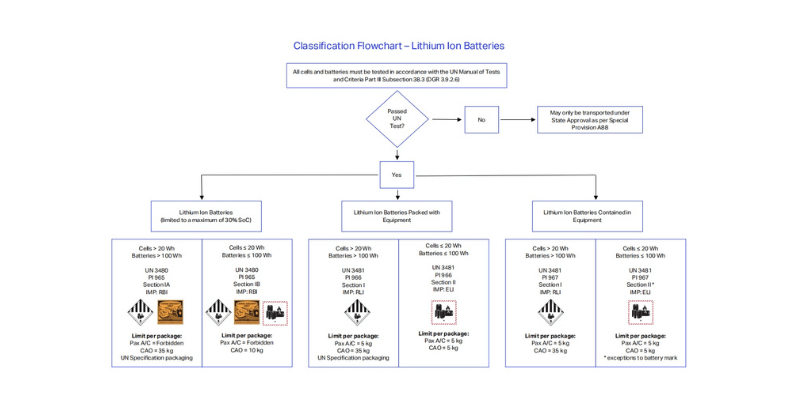ประเด็นสำคัญ:
- แรงดันไฟฟ้าเป็นส่วนสำคัญในการออกแบบชุดแบตเตอรี่แบบกำหนดเอง ซึ่งส่งผลต่อกำลังไฟฟ้าและความเข้ากันได้ของอุปกรณ์ ทำความเข้าใจแรงดันไฟฟ้าที่กำหนด ชาร์จ และคายประจุ และพิจารณาเคมีของแบตเตอรี่ ข้อกำหนดการใช้งาน และระเบียบข้อบังคับในการขนส่ง
การออกแบบ ก้อนแบตเตอรี่แบบกำหนดเอง ก็เหมือนกับการไขปริศนาที่ซับซ้อน คุณต้องคำนึงถึงข้อกำหนดด้านพลังงาน กระแสไฟ ความจุ ข้อกำหนดด้านขนาด การกำหนดค่าเซลล์ และจำนวนเซลล์ แต่มีสิ่งสำคัญชิ้นหนึ่งที่มักถูกมองข้าม นั่นก็คือแรงดันไฟฟ้า เรามาดำดิ่งสู่โลกอันน่าตื่นเต้นของแรงดันไฟฟ้าแบตเตอรี่และทำความเข้าใจถึงความสำคัญของมัน
แรงดันไฟฟ้าคืออะไร และเหตุใดจึงสำคัญ?
แรงดันไฟฟ้าก็เหมือนกับแรงดันน้ำในสายยางในสวนของคุณ มันผลักกระแสไฟฟ้าผ่านอุปกรณ์ของคุณ ยิ่งแรงดันไฟฟ้าสูง อุปกรณ์ของคุณก็จะยิ่งใช้พลังงานมากขึ้นเท่านั้น

ผลิตภัณฑ์ไฟฟ้าแรงต่ำและไฟฟ้าแรงสูง
อุปกรณ์มีความต้องการพลังงานที่แตกต่างกัน ผลิตภัณฑ์ที่มีแรงดันไฟฟ้าต่ำไม่จำเป็นต้องใช้พลังงานมากในการทำงาน ดังนั้นชุดแบตเตอรี่จึงต้องดันกระแสไฟฟ้าออกมาเพียงเล็กน้อยเท่านั้น ในทางกลับกัน ผลิตภัณฑ์ที่มีกำลังสูงต้องใช้พลังงานจำนวนมากในการทำงาน ดังนั้นผลิตภัณฑ์จึงต้องมีชุดแบตเตอรี่ที่สามารถจ่ายกระแสไฟออกมาได้มาก
การถอดรหัสแรงดันแบตเตอรี่
เพื่อทำความเข้าใจแรงดันไฟฟ้าของแบตเตอรี่ เราต้องพิจารณาสามสิ่ง:
1. แรงดันไฟฟ้าที่กำหนด
2. แรงดันไฟฟ้าเมื่อชาร์จเต็มแล้ว
3. แรงดันไฟฟ้าเมื่อคายประจุจนหมด
มาถอดรหัสคำศัพท์เหล่านี้กัน
แรงดันไฟฟ้าที่กำหนด
นี่คือแรงดันไฟฟ้าเอาท์พุตที่เซลล์จ่ายออกมาเมื่อชาร์จ มันเหมือนกับความเร็วเฉลี่ยของรถในการเดินทางไกล
แรงดันไฟฟ้าที่ชาร์จเต็ม
นี่คือแรงดันไฟฟ้าสูงสุดที่แบตเตอรี่สามารถเข้าถึงได้เมื่อชาร์จเต็มแล้ว มันเหมือนกับความเร็วสูงสุดที่รถของคุณสามารถเข้าถึงได้บนถนนเส้นตรง
แรงดันไฟฟ้าที่ปล่อยออกมาจนเต็ม
นี่คือระดับแรงดันไฟฟ้าต่ำสุดที่แบตเตอรี่สามารถเข้าถึงได้ก่อนที่จะพิจารณา “ว่างเปล่า”- มันเหมือนกับความเร็วที่ช้าที่สุดที่รถของคุณสามารถไปได้ก่อนที่มันจะหยุดเคลื่อนที่

แรงดันไฟฟ้าโดยเคมีแบตเตอรี่
รถแต่ละคันมีความเร็วต่างกัน แบตเตอรี่ต่างกันก็มีแรงดันไฟฟ้าต่างกัน ต่อไปนี้คือแรงดันไฟฟ้าที่กำหนดสำหรับเคมีของแบตเตอรี่ทั่วไปบางประการ:
1. NiCad : 1.2 โวลต์
2. NiMH: 1.4 โวลต์
3. ลิเธียมไอออน: 3.6 โวลต์
4. ตะกั่วกรด: 2 โวลต์
จำไว้ว่านี่เป็นเพียง “ความเร็วเฉลี่ย” – ผลลัพธ์ที่แท้จริงอาจแตกต่างกันไป
แบตเตอรี่ NiMH มีแรงดันไฟฟ้าปกติที่ 1.2V แต่สามารถจ่ายไฟได้สูงสุด 1.4V เมื่อชาร์จเต็มแล้ว แบตเตอรี่ NiCad และ NiMH มีแรงดันไฟฟ้าที่ชาร์จเต็ม 1.4V แบตเตอรี่กรดตะกั่วมีแรงดันไฟฟ้าที่ชาร์จจนเต็ม 2.1V ในขณะที่แบตเตอรี่ลิเธียมไอออนมีแรงดันไฟฟ้าที่ชาร์จเต็ม 4.2V
แบตเตอรี่ NICAD และ NIMH สามารถคายประจุได้อย่างเต็มที่ถึง 1.0V ในขณะที่แบตเตอรี่ตะกั่วกรดปล่อยไปที่ 1.75V แบตเตอรี่ลิเธียมไอออนไม่ควรถูกปล่อยออกมาอย่างเต็มที่เนื่องจากสามารถสร้างความเสียหายได้ คุณสมบัติการตัดความปลอดภัยช่วยให้มั่นใจได้ว่าแบตเตอรี่ลิเธียมไอออนจะไม่ต่ำกว่า 2.5V ถึง 3.0V

การกำหนดแรงดันไฟฟ้าสำหรับการใช้งาน
การกำหนดแรงดันไฟฟ้าสำหรับการใช้งานก็เหมือนกับการปรับสมดุลของกระดานหก ความต้านทานของการใช้งานเปรียบเสมือนน้ำหนักที่ปลายด้านหนึ่งของกระดานหก และกระแสก็เหมือนกับน้ำหนักที่ปลายอีกด้านหนึ่ง สมการนั้นง่าย:
แรงดันไฟฟ้า (V) = กระแส (I) x ความต้านทาน (R)
การใช้มิเตอร์วัดกระแสและแหล่งพลังงานที่ปรับเปลี่ยนได้สามารถช่วยในการกำหนดกระแสไฟที่ใช้สำหรับระบบได้ การจัดเตรียมนี้สามารถใช้เพื่อตรวจสอบทั้งแรงดันไฟฟ้าสูงสุดและต่ำสุดที่จำเป็นสำหรับระบบของคุณ การบันทึกการอ่านปัจจุบันเป็นสิ่งสำคัญ เป้าหมายของคุณควรคือการหาค่าที่อยู่ระหว่างการวัดทั้งสองนี้ ซึ่งจะแสดงถึงจุดที่มีการใช้พลังงานขั้นต่ำ
การทำความเข้าใจสเปกตรัมแรงดันไฟฟ้าในลักษณะนี้เป็นสิ่งสำคัญสำหรับผลิตภัณฑ์และการใช้งานที่อาจขึ้นอยู่กับแหล่งจ่ายไฟที่ผันผวน ในทางกลับกัน ผลิตภัณฑ์และแอปพลิเคชันบางอย่างจะมีการใช้พลังงานที่สม่ำเสมอ
ช่วงแรงดันไฟฟ้า
ผลิตภัณฑ์ทุกชิ้นมีช่วงแรงดันไฟฟ้าเฉพาะที่สามารถจัดการได้ก่อนที่จะเริ่มทำงานผิดปกติ มันเหมือนกับช่วงความเร็วที่รถยอมรับได้ หากขับช้าเกินไป เครื่องยนต์อาจดับได้ หากไปเร็วเกินไปอาจทำให้ร้อนมากเกินไป
ความจุและแรงดันไฟฟ้าของเซลล์
อีกปัจจัยที่สำคัญคือความจุของเซลล์ วิธีนี้จะกำหนดระยะเวลาที่ผลิตภัณฑ์ของคุณสามารถทำงานก่อนที่จะชาร์จแบตเตอรี่ใหม่ ใช้เป็นขนาดของถังแก๊สในรถของคุณ ความจุของเซลล์ที่ใหญ่ขึ้นหมายความว่าผลิตภัณฑ์ของคุณสามารถทำงานได้เป็นระยะเวลานานขึ้นด้วยการชาร์จครั้งเดียว ความจุของเซลล์ที่น้อยลงหมายความว่าคุณจะต้องชาร์จผลิตภัณฑ์ของคุณบ่อยขึ้น
ข้อจำกัดในการจัดส่งขึ้นอยู่กับแรงดันไฟฟ้า
การจัดส่งอุปกรณ์ไฟฟ้าแรงสูง โดยเฉพาะอุปกรณ์ที่ใช้แบตเตอรี่ลิเธียม จำเป็นต้องได้รับการดูแลเป็นพิเศษเนื่องจากอาจเกิดความไม่เสถียรได้ มันเหมือนกับการขนย้ายสารเคมีระเหย – คุณต้องปฏิบัติตามกฎระเบียบด้านความปลอดภัยที่เข้มงวดเช่น และ 38.3-
ตามแนวทางที่ กสท. กำหนดไว้ ไออาต้า, สามารถขนส่งแบตเตอรี่ที่ใช้ลิเธียมได้โดยอิสระหรือภายในอุปกรณ์ หากขนส่งแยกกัน สถานะการชาร์จ (SoC) จะต้องไม่เกิน 30%
นอกจากนี้ ปริมาณของเซลล์หรือแบตเตอรี่ที่สามารถขนส่งได้พร้อมกันจะถูกกำหนดโดยปริมาณของโลหะลิเธียมที่บรรจุอยู่ภายในแบตเตอรี่ และไม่ว่าจะมีการขนส่งภายในอุปกรณ์ แยกกันหรือร่วมกับอุปกรณ์ก็ตาม บรรจุภัณฑ์บางชิ้นอาจจำเป็นต้องมีเครื่องหมายเฉพาะเพื่อแสดงว่ามีแบตเตอรี่ลิเธียมอยู่ภายในบรรจุภัณฑ์

แรงดันไฟแบตเตอรี่สำหรับการออกแบบผลิตภัณฑ์
หากต้องการปรับแต่งชุดแบตเตอรี่สำหรับผลิตภัณฑ์ของคุณ คุณจะต้องพิจารณาปัจจัยหลายประการ รวมถึงแรงดันไฟฟ้า เคมี การจัดเรียงเซลล์ และขนาดของแบตเตอรี่ เป้าหมายคือการสร้างแบตเตอรี่ที่ให้พลังงานในปริมาณที่เหมาะสม ในขณะเดียวกันก็เหมาะสมกับข้อจำกัดด้านการออกแบบของผลิตภัณฑ์ด้วย
ตัวอย่างเช่น เซลล์แบตเตอรี่ NiMH หนึ่งแพ็ค 10 ก้อนสามารถจ่ายไฟได้ 14 โวลต์ในขณะที่รักษาต้นทุนให้ต่ำ อย่างไรก็ตาม เมื่อมีการเพิ่มเซลล์มากขึ้น แพ็คก็จะเทอะทะและหนักขึ้น วิธีแก้ปัญหาที่มีน้ำหนักเบากว่าอาจเป็นการใช้แบตเตอรี่ลิเธียมที่มีเซลล์น้อยกว่า อย่างไรก็ตาม แบตเตอรี่เหล่านี้จะต้องผ่านกระบวนการและข้อจำกัดการรับรองการขนส่งเพิ่มเติม ซึ่งอาจเพิ่มต้นทุนได้
บทสรุป
การเป็นพันธมิตรกับก ผู้ผลิตแบตเตอรี่แบบกำหนดเองที่ผ่านการรับรอง ในช่วงต้นของกระบวนการออกแบบสามารถช่วยได้มากในการหาแรงดันไฟฟ้าที่ต้องการ ที่ Holo Battery เราสามารถช่วยคุณกำหนดการออกแบบกล่องหุ้มแบตเตอรี่เพื่อให้แน่ใจว่ามีพื้นที่เพียงพอสำหรับกล่องนั้น ด้วยการออกแบบเหล่านี้ คุณสามารถทดสอบการทำงานของผลิตภัณฑ์และทำการปรับเปลี่ยนที่จำเป็นได้
บทความที่เกี่ยวข้อง:

